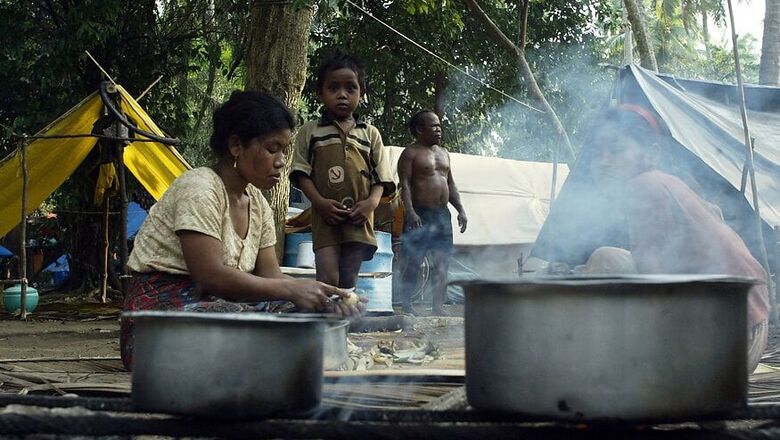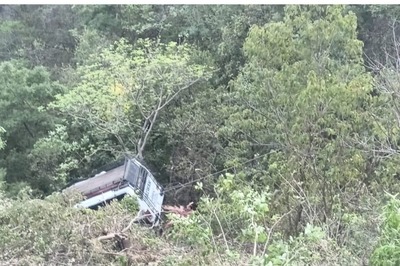
views
News18 brings to you a special series on the movement led by adivasis, which has spread across hundreds of villages in several states. We will publish a detailed immersive with videos, photographs, illustrations and ground reports from Jharkhand, MP and Odisha, soon.
Thousands of tribals across hundreds of villages in states with substantial adivasi population, including Jharkhand, Madhya Pradesh, Odisha and Chhattisgarh, have declared autonomy from India during the last one year.
In Jharkhand, it has taken shape in form of an armed exclusionary movement, and in Madhya Pradesh and Odisha, where the movement is still taking roots, it has taken form of a non-cooperative movement.
Through a symbolic movement called Pathhargarhi (placing a special stone outside a village), hundreds, possibly thousands of villages are being turned into an autonomous region. Some are calling it ‘adivasi corridor’, others are calling it ‘Adivasistan’.
By installing these stones that inform the beginning of a new order, an increasing number of villages are declaring themselves to be independent of 'Indian laws', a place where CrPC and IPC are not applicable.
Non-adivasis, including police forces, aren’t allowed inside the villages. And newly-constituted gram sabhas are taking on the role of executive, judiciary and legislature. Cases, ranging from theft to murder, are being taken up and adjudicated within these villages.
These villages even run their own schools where children, forced out of government schools, are being fed propaganda. So forceful has this movement become that in places like Odisha, an elected tribal MLA has taken over the task of Pathhargarhi on himself.
The police, who have often been roughed up by vigilante gangs from these villages, are clueless and are watching the movement unfold helplessly.
Vigilante gangs from these villages routinely clash with the police, often taking them hostage. In August last year, 100 policemen, including the district SP and 50 armed CRPF personnel, were taken hostage by such gangs in Jharkhand's Khunti district. Only after the intervention of the DIG were they let off.
Birsa, a tribal leader from Kurunga village, boasts about taking a group of 25 policemen hostage after the gram pradhan was arrested by the police. "We only let the policemen go once our gram pradhan was freed," said Birsa.
In other villages, like Bhandra in Khunti, the adivasis say they are "ready to give and take lives if our resources are threatened in any way."
Pathhargarhi takes its inspiration from an outlandish conspiracy theory, based on some forged documents, and supported by a misinformed reading of the Constitution, according to which adivasis have constitutional authority to declare self-rule in areas they dominate and are the actual owners of India.
They claim that our colonisers – the British, only transferred power to the 'Union of India' in 1870 on a 99-year lease that expired in 1969. And that, from now on all decisions affecting adivasis have to be approved by the 'privy council' of the British empire; rules made by electorally chosen institutions like Parliament or legislative assemblies don’t apply here. All identification cards like driving licence, voter ids, and Aadhaar are considered anti-Adivasi by nature.
"This stir is being created to allow poppy cultivators make money. The season ends in April. That's when their leaders will take their share and flee, and that's when we will move in," the SP, Ashwini Kumar Sinha, told News18.
But Pathhargarhi is flourishing as strongly in several villages inside Odisha's Sundergarh district and Madhya Pradesh's Dindori, areas where poppy isn't grown.
There are a lot of reasons attributed to the rapid rise in Pathhargarhi – police officials off the record say that the Naxals are aiding poppy cultivation in Jharkhand and Pathhargarhi is just a cover for it. Some say that it is a ploy by opposition parties to rally adivasis against the ruling parties, other call it a ploy by missionary institutions to spread unrest in order to protect their areas of influence.
One such village was Sonpur, where News18 witnessed the Pathhargarhi ceremony. There were thousands of tribals, including women and children, about 3,000 of them who’d come armed with bows, arrows, machetes and axes, as if preparing for war.
There was a huge ceremony in which a wanted tribal leader, a man named Joseph Purti, inaugurated the stone. More than 60 villages in Khunti district are Pathhargarhi villages now. Some villages don’t subscribe to the idea of self-rule, but there is little they, or the administration, can do about it.
But it isn’t the quack theory of adivasis being rulers of India, alone. Adivasis talk about decades of neglect in their areas, where most people are still below poverty line, where potable water is in short supply and electricity has still not reached.
Adivasis talked about the plight of those tribals who were not told about these big-ticket projects like dams in advance, and were left homeless because the state governments didn’t compensate them or provide them with an alternative shelter. They were angry, they said, because industries had swallowed up their villages completely, rendering them homeless. When these flourishing industries gave them nothing, the adivasis felt even more alienated.
“So divorced is the state from us adivasis that they are creating fast rail projects in our areas, ignorant of the fact that we’re dying of hunger out here,” an adivasi from a village near Dindori in Madhya Pradesh told us.
It’s hard to tell what direction this movement will take in days to come. But the tribals don't mince their words when they talk about dying or killing for their cause. Election boycott calls are rampant and the elected representatives are not welcomed in these villages anymore.
Pathhargarhi, and consequently this movement among the tribals, is spreading like wildfire. And the state administration seems to have no clue of how to deal with it, at least for now.




















Comments
0 comment